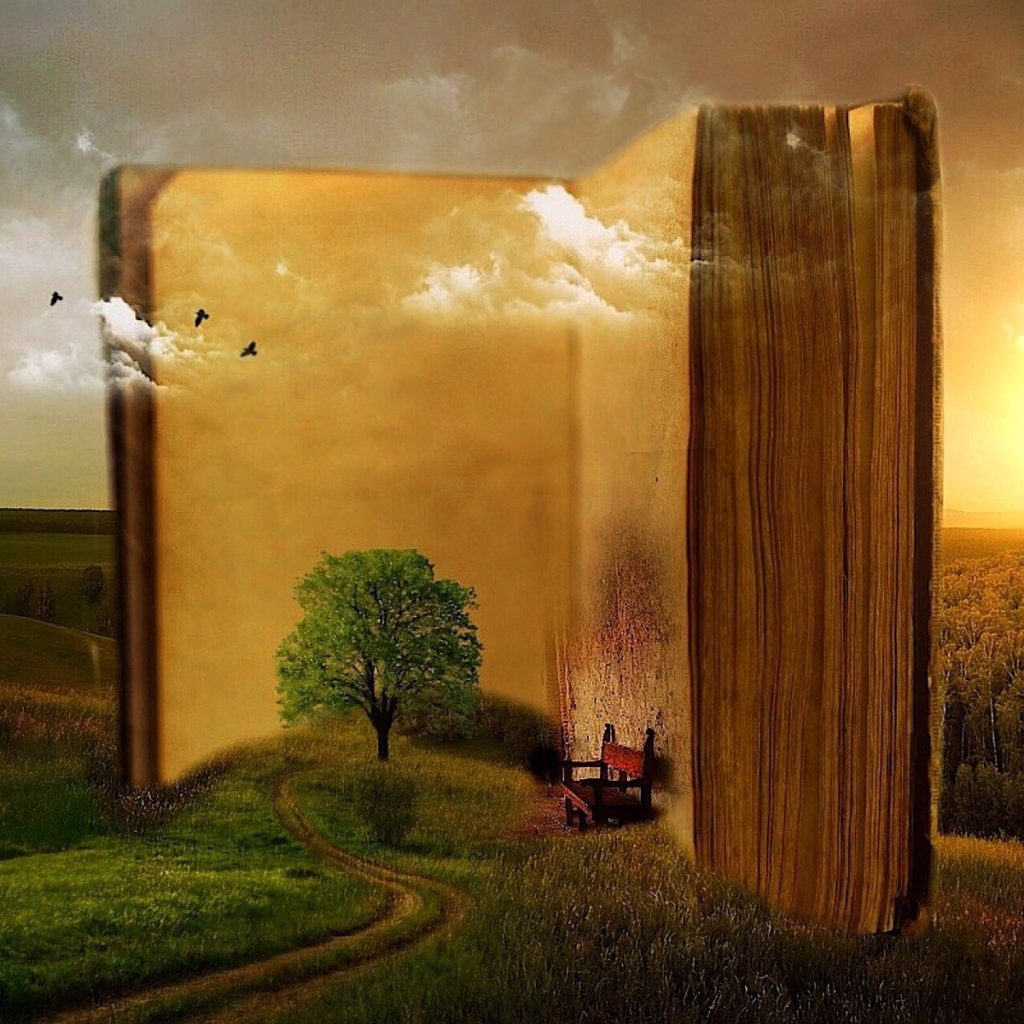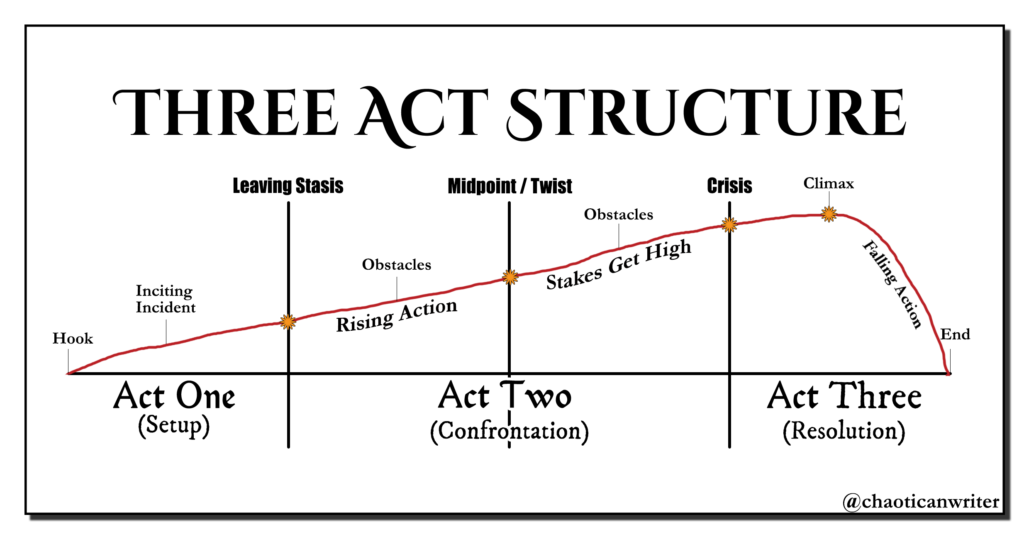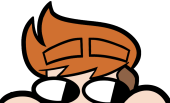
Prologue
Since before starting Chaotican Writer, I had been an aspiring author, working away at a dark fantasy novel that I had wanted to write for years.
In fact, the site you see before you actually started as my attempt at a writers platform in order to chronicle my journey, and perhaps stir up hype for it in advance. Quickly, I realized that running a website was its own massive hill to climb, and I had trouble separating my love for fantastical stories with my love table-top gaming. The site managed to take its own form, and ultimately outlasted my working on the novel. The novel now sits in backup somewhere, unfinished and invisible to the world.
However, since starting that journey, I had taken a fascination to story structure, and how we as writers and world builders tell our tales. I became a bit of an obsessive for a time, and I devoured multiple books and resources on the subject.
This article here is something I’ve written a while back, but felt uncertain whether I could justify being an authority on it. I havent actually published a novel, so… am I really in the authority to teach about how story structure works?
That being said, I realized over the past year that knowledge going to waste is a terrible thing. As someone who had a sincere attempt, and may some day come back to it, I have educated myself on an array of information about story structure along the way. I believe there is still a duty to share, even if it is coming from a point of an incomplete journey. Its why I started the site anyhow!
Going forward, my chief advice to you, the reader, is to take this resource as a tool in your toolkit, amongst other resources written by more storied individuals. I’ve curated a handful of ideas (see sources at the bottom), and bring them to you as a collection!
Please review the sources at the end of this article for more information, and feel free to reach out if you have questions.
Happy Writing, and I hope this piece is useful and informative!
– Matt @ Chaotican Writer
The Importance of Structure
Every good story needs a plan.
Many storytellers, authors, and screenwriters often put their ideas in an outline before committing their full word count onto a page. This comes in handy, since the direction of a story can take hundreds of different turns. Some of them organic. Others derailing.
Often times, outlining means dividing up that story into smaller sections. Depending upon the format, this can take on many different forms. A novel, for instance, has chapters. A screenplay has scenes. A theatrical performance has acts. Everything has a beginning, middle, and end.
What exactly makes an "Act"?
How do you determine which act is which? Where do you draw the line between the three? What events make up an act? How to you end each act, and how do you move the story forward into the next one?
Truth is, there is no single answer. Screenplay writers and novelists swear by different structures to accomplish this, and different mediums call for different plans.
One-Act stage plays. Three act novels. Five act movie screenplays. Seven act TV shows, one for each commercial break. One size does not fit all.
But all stories can be divided into these smaller divisions we know as “acts”, and the purpose of each act is to create a division in the story, and to better mark the beats that are necessary to propel the story forward.
From a limited perspective, this can be true for unconventional formats as well; TTRPG campaign podcasts with a more cinematic flair, such as Critical Role and The Adventure Zone, often follow the same kind of story beats, whether the Game Master planned it that way or not.
Characters and setting are introduced. These characters begin in stasis, but are confronted with new realities, and forced to make a choice. They embark on their journey, struggling against obstacles and learning about their new reality. After an intense set-back, the characters prepare for a showdown against the source of their troubles, whether physical or psychological. The peak of tension is followed by our characters dealing with the aftermath, and the story’s closure.
What is Three Act Structure?
Enter the Three Act Structure: by far the most common and widely recognized structures for storytelling in media. Its so ubiquitous, you can break down nearly every movie, book, TV show, and story podcast by this format, and identify the precise points when one act moves to the next, and what event causes it.
While it has been around for aeons, its mark in modern storytelling academia draws most of its lineage from Screenplay: The Foundations of Screenwriting, a novel by Syd Field originally published in 1979.
Its pages provide a number of key insights on how story’s and screenplays come together, defining structure as the relationship between the parts and the whole, and marking a stories plot points in clear context: any incident, episode, or event that hooks into the action and spins it around in another direction, which is always the function of the main character(s).

Think about a game of chess. Its a whole game, but it comes in multiple parts. The pieces, the players, the board, and the rules. A story is built in much the same way. Characters, action, setting, conflict, dialogue, scenes, how they unravel in each act. … The relationship between all of these parts is what makes a whole story.
For this article, I’ve selected three shining examples of films that follow three-act-structure, and since this is a site that loves to embrace fantastical action, these are the four I’ve chosen:
- Star Wars: Episode IV (1977)
- Lord of the Rings: The Fellowship of the Ring (2001)
- The Hunger Games (2012)
- Mad Max: Fury Road (2015)
Notice: This article is a liberal adaptation of multiple takes on the Three Act Structure, borrowing from Syd Fields interpretation, the Save the Cat method, and other alternatives. My largest takeaway as the writer of this article has been this; There is no precise science to how we label or qualify each section, or which story beat happens at which moment, or that one or any version is a precise match for the wide array of genres and mediums that exist. In some of the examples I’ve studied in assembling this article, there have been differing takes on when a plot point happens and why, and with reasoning that makes sense in certain contexts.
That being said, I believe the best approach is to highlight a handful of these concepts from variants of the structure, and pair them with events in the above firms/stories. The overall purpose of this article is to provide a consolidated view of Three Act Structure, and I would highly encourage readers to check out the source examples to get a feel for where the differences in interpretation lie. At the end of the day, story structures are an active, living database of concepts that come together to highlight narrative patterns; not a strict or static ruleset to create by.
Lets break down the struture!
However, Three Act Structure is more than just beginning, middle, and end. Rather, the divisions are defined as: the Setup, the Confrontation, and the Resolution.

As it turns out, there are multiple variants of three-act structure that provide a more characterized or nuanced look at stories of particular genres and styles. Here are just a few of them, and how their main beats in Act One compare.
Syd Fields Three-Act
- Opening Hook
- Inciting Incident
- Plot Point 1
The Heroes Journey
- Ordinary World
- Call to Adventure
- Refusal of the Call
- Meeting the Mentor
- Cross the First Threshold
Save The Cat Beat Sheet
- Opening Image
- Theme Stated
- Set Up
- Catalyst
- Debate
- Break Into Two
Granted, story structure is not an exact science. It is not uncommon to see resources using terms from multiple variants to describe the story beats of a narrative.
Therefore, in order to make the best of this information, our breakdown of these acts will be accompanied with terms from these variants in order to better articulate their roles in the story, and how our examples supply them.
Act One: The Setup
The goal of Act 1, is to set up story by establishing the characters, the dramatic premise, the situation, and the relationships between characters.
Syd Field states that while the first act should take up about 25% of the story, or about 20-30 pages, but… you often only have about 10 minutes or 10 pages to grab the audience attention. (If these pieces aren’t in place by then, you’re in trouble.)
The Opening Hook
Curtains open, and the first scene is set. The moment the story officially opens reveals to us a glimpse of our setting and characters. It is where the initial promises are handed to the reader; this is where we begin, and this is where we are going.
The opening hook / scene is essential for grabbing the attention of the reader, and immersing them into its initial twists and turns. It introduces our dramatic situation and dramatic premise that sends us into the rest of the story, and sets the mood going forward.
- Princess Leia is captured by Darth Vader, and our two droids (C3P-O and R2D2) escape onto Tattoine. The mood is action, suspense, and a bit of droid humor.
- The War of the Ring ends, and we see it eventually fall into possession of an unwitting hobbit, Bilbo Baggins. Years later, we see Gandalf and Frodo in the Shire for Bilbos 111th birthday. … The mood is a mix of dark wars and lighthearted fun.
- District 12 is a poor and hungry place. Katniss hunts with her bow for food, Gale debates the prospect of leaving, and they return to witness The Reaping for the next Hunger Games. … The mood evokes what it is like to fight for survival in a dystopia.
- Max is captured by the War Boys, and we see the Citadel, a thirsty and oppressive oasis in a brutal desert. Immortan Joe initiates a ceremony to send Furiosa off to Bullet Town with a war rig. … The mood is chaotic and desperate.
Your story can begin with the hook from the very first sentence, or it can reveal itself throughout that first scene. However the case, it must be compelling enough to pull your audience in from the start. From there, you have an obligation to keep those promises to the reader, and assure them that they will see more of this tangled web unravel.
ADDITIONAL: Opening Image, Theme Stated, and Set-up
Another way to break this down (under the Save the Cat Beat Sheet) is to take the opening image (literal first scene), theme stated (dialogue or metaphor to encapsulate the story) and set-up (events leading to the protagonists appearance) independently.
For example, in Star Wars, the opening text crawl tells us what we need to know about the image, the initial space battle shows us the theme, and the set-up begins with Leia’s escape, and the droids introduction.
In Lord of the Rings, the image is the telling of the history of the ring, the theme is clear in one sentence (“One ring to rule them all.”), and the rest is the set-up, which accounts events from the battle to Bilbos birthday.
The Inciting Incident
Once we get an opportunity to see our protagonist, we see them in their current state before the events of the story progress. This ordinary world gives us a glimpse of who they are, and how they interact with their environment.
However, our protagonist will eventually encounter the Inciting Incident, something that triggers a deviation from the status quo. Something isn’t orderly with the world. Something is about to change.
- The droids end up in the possession of Luke Skywalker, who manages to see the distress call from Princess Leia while trying to fix R2d2.
- Gandalf realizes something unnatural is happening with Bilbo and his strange ring. He gives it to Frodo for safe keeping, and leaves the Shire to research and investigate.
- Prim, Katniss’s sister, is chosen as tribute for the Hunger Games, and Katniss must act!
- Furiosa departs from the Citadel on the war rig, accompanied by a band of War Boys. Max is taken along for the ride as a trophy, strapped to the front of a car.
ADDITIONAL: The Call To Adventure
Granted, the inciting incident, which is most of the time the same as the catalyst, will be different depending on which character you are speaking about. For princess Leia, it was delivering the distress message to R2D2. For Furiosa, it is the moment she decides to pull off the road to Bullet Town.
At this point, the protagonist will need to make a choice between their old life, and the one staring them in the face. In some stories, this can happen abruptly with no second thought. In others, This can be part of a larger plan, a situation for the character to process, or can happen immediately. The Call of Adventure has begun!
- R2D2 leaves in the middle of the night, sending Luke to track them down. They encounter Obiwan (Ben) Kenobi, who receives the distress call. He asks Luke for help on this quest.
- Gandalf returns to the Shire, revealing to Frodo that he possesses the “One Ring”, and must leave the Shire immediately. He begs Gandalf to take it, but Gandalf refuses. After uncovering Sams eavesdropping, he sends both hobbits toward the Prancing Pony.
- Quickly, Katniss steps forward and volunteers for tribute, freeing her sister from the games, but submitting herself.
- We find out Furiosa liberated women who Immortan Joe had taken as “wives”, and smuggled them into the War Rig. She executes her plan to defect from the War Boys and flee with the rig, initiating a chase.
The First Plot Point
Things don’t always go smoothly, however.
Characters don’t always take the bull by the horns from the get go. They sometimes engage in debate, or a refusal of the call upon being confronted with this new world. Change is scary! … Sometimes they do require meeting the mentor to understand what is at stake. However, one way or another, they are going to have to face the new reality.
Alas, we’ve arrive at the first plot point in this structure. This is the true beginning of the story, and is what will eventually swing our characters into the next act. This event does two things; it sets the story into motion, and grabs the attention of the reader/viewer. We have reached a point where the danger is realized, and the character knows what the stakes are. There is no going back!
- Luke encounters massacred jawas, as Obiwan recognizes Imperial Storm Troopers are responsible. Luke realizes where this would lead them, and rushes back home
- Frodo and Sam begin their journey, but Sam realizes that this is the furthest he’s ever been from home. They decide to press on. However, shortly after, they (plus Mary and Pippin) encounter the Ring Wraiths.
- Katniss is forced to say goodbye to her friends and family, but Madge (the mayors daughter) provides her a Mockingjay pin; a symbol of hope.
- Sandstorm! Nux, the rider of the car, crashes. Afterward, Max drags Nux and catches up with Furiosa and the War Rig. After a small battle, Max is given a choice to help Furiosa while still helping himself.
Leaving Stasis
This section is less of an official phase, but an extension of the First Plot Point that serves as the line of transition. Once our characters full process the aftermath of the incident, and the stakes of making change, they will need to make the final decision; either remain in stasis, or cross the first threshold / break into two.
- With Lukes home burned and family killed. he realizes he has nothing to come back to. His only way forward is with Obiwan to Mos Eisley.
- In a subtle yet symbolic scene, partway through their journey from the Shire, Sam realizes that this is the furthest he’s ever been from home, and hesitates. After a moment of reflection and reinforcement, they decide to press on.
- Katniss arrives at the capitol, a city of immense wealth and indulgence. She is sent to be transformed via makeover from the poor denizen of District 12, to the “shining example” of a Hunger Games tribute. During her demonstration before the Gamemakers, she shoots an apple out of a roast pigs mouth in frustration, thus impressing them, and committing her as a standout candidate.
- Furiosa convinces Max to work together on escaping. Max comes to terms with his lone wolf tendencies, and decides to embark with Furiosa.
Naturally, our story would not move forward unless the decision to leave the ordinary world is made, and our characters make a conscious effort to step into the new world. This defines the line between Act I and Act II; and that decision is what makes us embark with the main characters on their journey.

Now that we’ve taken a look into the beats of Act I, how do you think the rest of the story progresses? What story beats is one likely to find in Act II and III?
We’ll examine this next, as our three part series continues! … Stay tuned for our breakdown into Act Two.
In the meantime, please review and check out our chosen sources for this article!
Sources (and Special Thanks)!
- The bulk of the above material is derived from the book:
- Screenplay: The Foundations of Screenwriting by Syd Field
- Much of the material was assisted with knowledge about the Save the Cat method
- Save the Cat – An Overview + FREE Template by Alex D. Reid
- Finally, the material for the Heroes Journey was derived from Joseph Campbells work.
- The Hero With a Thousand Faces by Joseph Campbell
- To better differentiate the Inciting Incident from the Call to Adventure:
- Call to Adventure and Inciting Incident: NOT the Same Thing by M. Richards
- To better differentiate the First Plot Point from the previous Act I beats:
- Story Structure Part 3: The First Plot Point by Savannah Gilbo
- For the analysis behind each of the four mentioned films/novels, these links were essential in informing their representation. Special thanks to these teams, and the authors behind these pages:
- STAR WARS: A NEW HOPE
- LORD OF THE RINGS: FELLOWSHIP OF THE RING
- Beat Sheet (Lord of the Rings: Fellowship of the Ring) by Quin Smith
- The Fellowship of the Ring: Story Structure Database submitted by Zachary Holbrook
- THE HUNGER GAMES
- The Hunger Games Novel Beat Sheet by Jessica Brody
- The Hunger Games Story Arc Key Scenes and Example by Sherry Leclerc
- MAD MAX: FURY ROAD
- Helping Writers Become Authors: Mad Max: Fury Road by Rocky Persaud
- Movie Analysis: “Mad Max: Fury Road” — Plot by Scott Myers
- Axolotls, Genies, and Kaiju; a Quick TTRPG Zine Roundup #2 - May 19, 2025
- d100 City Encounters and Urban Sidequests - April 26, 2025
- Dirtbags! a Sci-Fi Shooter RPG: Gameplay Review! - March 23, 2025


